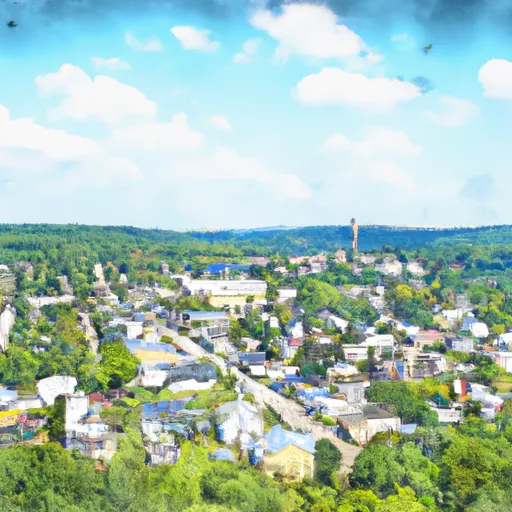-
 Snoflo Premium
Snoflo Premium
Get unlimited access to all our content
With no Ad interruptions! - Start Your Free Trial Login with existing account
Sugar-Grove
Eden Index
Climate
8.3
•
Recreation
3.1
•
Community
•
Safeguard
4.4/10

Sugar Grove, Pennsylvania is a charming community located in Warren County, in the northwestern part of the state. The region experiences a humid continental climate, characterized by warm summers and cold winters. Average temperatures range from the mid-80s Fahrenheit in summer to the mid-20s in winter. Precipitation is evenly distributed throughout the year, with snowfall common during the winter months.
Hydrologically, the area is blessed with numerous lakes, rivers, and streams. The Allegheny River flows nearby, providing opportunities for fishing, boating, and kayaking. The region is also dotted with smaller lakes and ponds, offering great spots for swimming and picnicking. Nature enthusiasts can explore the beautiful Allegheny National Forest, which surrounds Sugar Grove. This vast forest is home to breathtaking hiking trails, scenic overlooks, and abundant wildlife, providing ample opportunities for outdoor recreation.
With its picturesque surroundings and diverse range of outdoor activities, Sugar Grove, Pennsylvania is a paradise for nature lovers, offering a tranquil and adventurous escape from the hustle and bustle of everyday life.
What is the Eden Index?
The Snoflo Eden Index serves as a comprehensive rating system for regions, evaluating their desirability through a holistic assessment of climate health, outdoor recreation opportunities, and natural disaster risk, acknowledging the profound impact of these factors on livability and well-being.
Climate Health Indicator (CHI): 8.3
Sugar-Grove receives approximately
1161mm of rain per year,
with humidity levels near 79%
and air temperatures averaging around
8°C.
Sugar-Grove has a plant hardyness factor of
5, meaning
plants and agriculture in this region thrive during a short period during spring and early summer. Most
plants will die off during the colder winter months.
By considering the ideal temperature range, reliable water supplies, clean air, and stable seasonal rain or snowpacks, the Climate Health Indicator (CHI) underscores the significance of a healthy climate as the foundation for quality living.
A healthy climate is paramount for ensuring a high quality of life and livability in a region, fostering both physical well-being and environmental harmony. This can be characterized by ideal temperatures, reliable access to water supplies, clean air, and consistent seasonal rain or snowpacks.
Weather Forecast
Streamflow Conditions
Allegheny
Area Rivers
Allegheny
Snowpack Depths
Allegheny
Reservoir Storage Capacity
Allegheny
Groundwater Levels
Recreational Opportunity Index (ROI): 3.1
The Recreational Opportunity Index (ROI) recognizes the value of outdoor recreational options, such as parks, hiking trails, camping sites, and fishing spots, while acknowledging that climate plays a pivotal role in ensuring the comfort and consistency of these experiences.
Access to outdoor recreational opportunities, encompassing activities such as parks, hiking, camping, and fishing, is crucial for overall well-being, and the climate plays a pivotal role in enabling and enhancing these experiences, ensuring that individuals can engage in nature-based activities comfortably and consistently.
Camping Areas
| Campground | Campsites | Reservations | Toilets | Showers | Elevation |
|---|---|---|---|---|---|
| Redbank Valley Municipal Park | None | 1,135 ft | |||
| Kellettville Rec Area Tionesta Lake | None | 1,155 ft | |||
| Cook Forest State Park | None | 1,554 ft | |||
| Chapman State Park | None | 1,440 ft | |||
| Milton Loop | None | 1,150 ft | |||
| Tionesta Rec Area - Tionesta Lake | None | 1,078 ft | |||
| Hearts Content Rec Area | 36 | 1,903 ft | |||
| Lake Erie State Park | None | 623 ft | |||
| Buckaloons Rec Area | 132 | 1,164 ft | |||
| Minister Creek and Trailhead | 26 | 1,235 ft |
Nearby Ski Areas
Catastrophe Safeguard Index (CSI):
The Catastrophe Safeguard Index (CSI) recognizes that natural disaster risk, encompassing floods, fires, hurricanes, and tornadoes, can drastically affect safety and the overall appeal of an area.
The level of natural disaster risk in a region significantly affects safety and the overall livability, with climate change amplifying these risks by potentially increasing the frequency and intensity of events like floods, fires, hurricanes, and tornadoes, thereby posing substantial challenges to community resilience and well-being.
Community Resilience Indicator (CRI):
The Community Resilience Indicator (CRI) recognizes that education, healthcare, and socioeconomics are crucial to the well-being of a region. The CRI acknowledges the profound impact of these elements on residents' overall quality of life. By evaluating educational resources, healthcare accessibility, and economic inclusivity, the index captures the essential aspects that contribute to a thriving community, fostering resident satisfaction, equity, and social cohesion.

